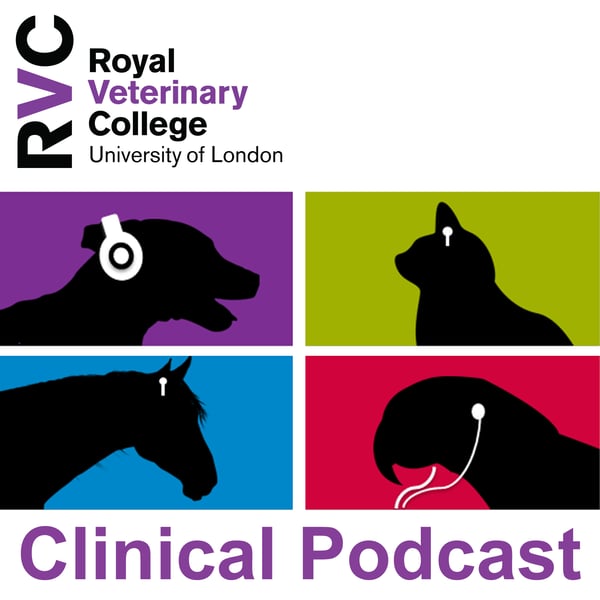72 HCM in cats
Veterinary Clinical Podcasts
Dominic Barfield
5 • 643 Ratings
🗓️ 20 April 2018
⏱️ 31 minutes
🧾️ Download transcript
Summary
Today Brian and I finally manage to lure Associate Professor David Connolly into the studio (we had to bribe with cake). David is a RVC stalwart, and a member of the Cardiology team. We cover approach to diagnosis and treatment with a bit of jumping around here and there. Don't forget your stethoscope, and your ultrasound. And maybe your ECG. We hope that you enjoy.
Some articles of interest (there are quite a few):
Risk factors for cats with HCM
https://www.ncbi.nlm.nih.gov/pubmed/26776589
Cardiac troponin I in cats with HCM
https://www.ncbi.nlm.nih.gov/pubmed/25319115
https://www.ncbi.nlm.nih.gov/pubmed/12878148
Prognostic indicators in cats with HCM
https://www.ncbi.nlm.nih.gov/pubmed/24134821
N-terminal pro B-type natriuretic peptide (NT-proBNP)
https://www.ncbi.nlm.nih.gov/pubmed/29262821
https://www.ncbi.nlm.nih.gov/pubmed/26813037
https://www.ncbi.nlm.nih.gov/pubmed/24283418
On transient myocardial thickening in cats.
https://www.ncbi.nlm.nih.gov/pubmed/29243322
If you have any comments about this podcast, please get in touch: email [email protected]; tweet @dombarfield. We would greatly appreciate your time to rate us on Apple podcast or Acast and kindly write us a review.
Transcript
Click on a timestamp to play from that location
| 0:00.0 | Goodaid, Dominic Barfield here, and this is the RVC Clinical Podcast. |
| 0:03.0 | Thank you for listening and thank you for subscribing on your smartphone or generic fruit-based device. |
| 0:07.0 | We're really grateful for you taking the time to download and listen to this |
| 0:10.0 | obviously podcast and you don't ask for much in return. |
| 0:12.0 | Well, not really anything. |
| 0:13.0 | But we'd be incredibly grateful if you could pop to Apple Podcast or ACAST or wherever you actually download this podcast and leave us a review. |
| 0:20.0 | Obviously, a five-star review would be great. |
| 0:21.9 | Other reviews, please give them to other shows. |
| 0:24.1 | And we really appreciate if you could just spend a couple minutes of your time to do that for us. |
| 0:28.4 | So today in the studio, joining Brian and myself, we're going to talk to Associate Professor David Connolly, one of our cardiologists here at the RBC. |
| 0:35.7 | So many thanks, David, for finally agreeing to |
| 0:37.6 | joining us in the studio. He says that under Broti Brow, I'm not even going to say about |
| 0:43.0 | the bribe that I had to offer him to come in here. So we're going to talk about hypertrophic |
| 0:48.1 | cardiomyopathy in Katsar. So maybe my first question to you is in your physical assessment, or how do we actually |
| 0:56.3 | diagnose hypertrophic cardiomythia in cats? The gold standard, unfortunately, in some ways, |
| 1:02.0 | is echocardiography, cardiac ultrasound, because one of the problems with hypertrophic cardiomy |
| 1:08.3 | is it's very common, and it can be silent in that there |
| 1:13.8 | could be no clinical signs in the pre-clinical period. And so a cat may not even have a murmur. |
| 1:20.0 | Unfortunately, there are an awful lot of cats out there which have murmurs and don't have any |
| 1:23.8 | underlying structural heart disease. So cats are quite difficult from that point of view. So if you hear a murmur and a cat doesn't necessarily mean that it's got a disease, |
| 1:31.3 | let alone hypertrophic cardiomyopathy. |
| 1:33.3 | Less commonly, but it is possible that you can have a cat without a murmur which has quite severe hypertrophic cardiomy path. |
... |
Please login to see the full transcript.
Disclaimer: The podcast and artwork embedded on this page are from Dominic Barfield, and are the property of its owner and not affiliated with or endorsed by Tapesearch.
Generated transcripts are the property of Dominic Barfield and are distributed freely under the Fair Use doctrine. Transcripts generated by Tapesearch are not guaranteed to be accurate.
Copyright © Tapesearch 2025.

